America’s First Military Academy, the Pluckemin Academy (Dec.1778) was
Called the Pluckemin Winter Cantonment, part of the overall Middlebrook Encampment of 1778-1779.
24 Years BEFORE West Point (Mar. 16, 1802).
One of the greatest untold stories of the American Revolution.
One of the lesser-known stories of the American Revolution is the truth about the Pluckemin Encampment, also known as the Pluckemin Cantonment. You see, a cantonment is different than an Encampment because a cantonment has actual buildings versus temporary tents. Back in 2005, we started on a quest to expose this story. While the notes below are raw, we’ve left them in their original state so you can see what we knew then. There are a number of research efforts that have come from this piece. See the links at the end of this post.
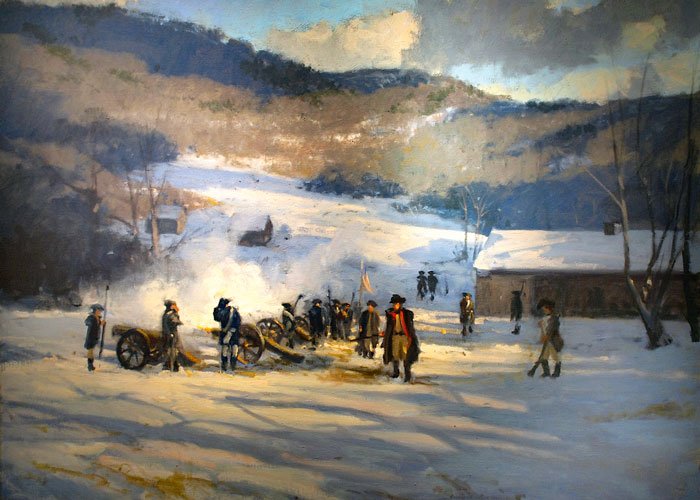
Many people still don’t know about the treasure on the hillside in the sleepy little hamlet of Pluckemin in Bedminster Township, New Jersey. With the help of groups like the Friends of the Jacobus Vanderveer House, the story is coming to light, and there soon may be a museum to recognize one of the greatest untold stories of the American Revolution.
It all started with this 1779 drawing that was lost in the US government archives.
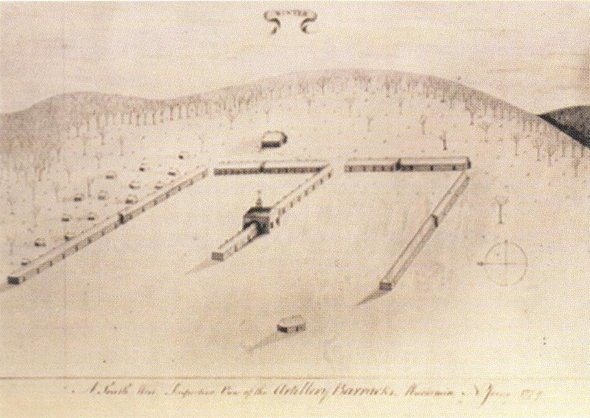
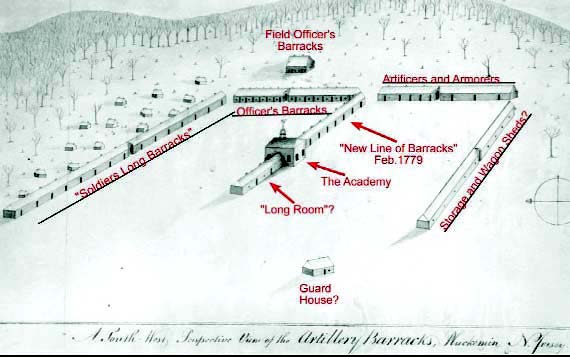
The video below shows a grant from the Somerset County Cultural and Heritage Commission to the Friends of the Jacobus Vanderveer house. Brooks Betz served as the Project Manager for the grant’s execution. Instead of producing a physical model of the cantonment, a virtual model was created with the help of John Seidel, archeologist lead of the 2nd Pluckemin Dig. John is also a professor at Washington College in Maryland.
General Knox’s Artillery
General Henry Knox had innovative ideas for improving the Continental Army’s artillery. At Pluckemin, he put many of his theories into practice. The camp itself at the time was an impressive site that attracted spectators from miles around. In addition to barracks for the enlisted men and separate quarters for the officers, the camp included an Armour’s shop, a complete military forge, and a laboratory. The most significant innovation, however, was the establishment of the first military academy in the country for the training of artillery and engineering officers, therefore becoming the forerunner to the Academy at West Point.”
However, those barracks, buildings, and academy at the Pluckemin encampment disappeared shortly after the end of the Revolutionary War. Since then, most of the site has been intensively developed with a residential development called “The Hills.” But in the late 1970s, before the Friends of JVH was around, a non-profit Pluckemin Archaeological Project sponsored a dig that recovered thousands of artifacts. Much was learned about the Revolution from the project.
On the slopes of the Second Watchung Mountain was the first artillery academy. Twelve acres of land were owned by Allan-Deane, a Johns Manville subsidiary.
The 1779 Grand Alliance Ball – Pluckemin
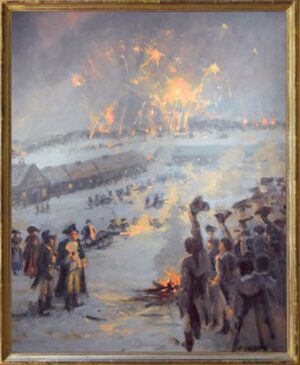
The barracks of the artillery are at a small distance from Pluckemin, on a piece of rising ground, which shows them to great advantage. The entertainment and ball were held at the academy of the Park. About 4 0’clock in the afternoon, the celebration of the ALLIANCE was announced by the discharge of thirteen cannon, when the company assembled in the academy to a very elegant dinner. The room was spacious, and the tables very prettily disposed, both as to prospect and convenience. The festivity was universal, and the toasts descriptive of the happy event, which had given certainty to your liberties, empire, and independence. In the evening was exhibited a very fine set of fireworks, conducted by Col. Stevens, arranges on the point of a temple, one hundred feet in length, and proportionally high. The temple show THIRTEEN arches, each displaying an illuminated painting. The center arch was ornamented with a pediment, larger than any of the other(s); and the whole edifice supported by a colonnade of the Corinthian order.
(John W. Barber, and Henry Howe, Historical Collections of the State of New Jersey, pages 441-442)
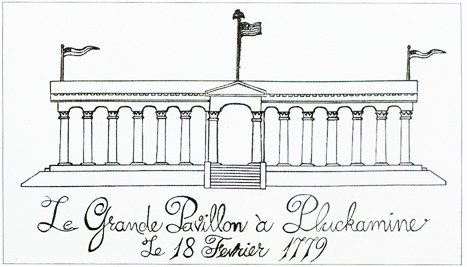
When the fireworks were finished, the company returned to the academy, and concluded the celebration by a very splendid ball. The whole was conducted in a style and manner that reflects great honor on the taste of the managers. The news announced to congress from the Spanish branch of the house of Bourbon, arriving at the moment of celebration, nothing could have so opportunely increased the good- humor of the company, or added to those animated expressions of pleasure which arose on the occasion.
The Archaeological Dig
Historian Clifford Sekel began studying the artillery park (1972). Archaeologist John Seidel joined Sekel and fieldwork began in 1979 and continued through 1986. Financial support came from the not-for-profit Pluckemin Archaeological Project and the Hills Development Corporation.

Ground penetrating radar (GPR) and magnetometry, a process that employs an instrument that recognizes differences in soil magnetism, are used. An entire site is mapped, and then differences are recognized. Transitions in magnetic intensity usually recognize archaeological features.
The Jacobus Vanderveer House – Knox Wartime Residence
During the winter of 1778-1779, the main Continental Army under George Washington established its winter encampment near Middlebrook, New Jersey. Over 8,000 infantry and artillery soldiers spent about 6 months at this location. The Continental Artillery Park was located at Pluckemin, New Jersey, several miles north of the infantry camps. At this location, the artillerists built barracks for almost 1000 men and established a depot, repair facilities, and an academy for artillery officers. This encampment was abandoned by the Army in June 1779. In the 1980s, archaeological excavations by Rutgers University exposed remains of the “Artillery Park” and recovered thousands of artifacts.
The Hopkinson American Flag @Pluckemin and that Buckle
Two artifacts found at Pluckemin have changed the view of the early American flag and it’s use by the Continental Army. These decorative belt tips probably adorned the ends of officer’s “over the shoulder” leather sword belts. Each of these belt tips is hand engraved and bears almost identical designs of a cannon, flagstaff, and flag, a motif very similar to that found on American artillery buttons of the period. These belt tips had never been seen before and their use by the American army was previously unknown. What made them all the more spectacular was the fact that they both showed a new orientation of the stars on the field of the American flag, five stars, over three stars, over five stars.
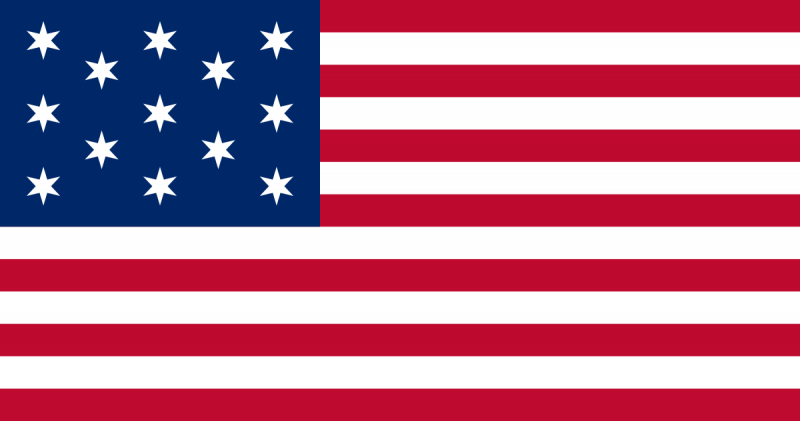
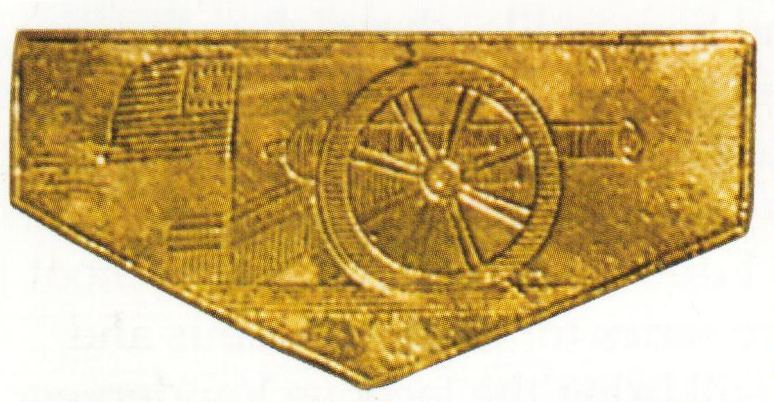
The Dig Find that solved the clue about the flag
These belt tips were the earliest known artifacts to clearly show the American flag. It is believed that they were engraved by a Philadelphia silversmith whose records show he was called to the camp in early 1779. If this is true, it is probable that he engraved the flag design based on what the army was actually using in camp at the time.
While this does not tell us exactly what the 1777 flag was supposed to look like, it does prove to us that the Continental Army was using the “Stars & Stripes” flag by 1779 and the star orientation (constellation) was of a different type than previously thought. The earliest provable American flag design was 13 stars laid out in rows of five, three, and five. Since the discovery of the artillery belt tips at Pluckemin, two more have been discovered. One was found in a mid-1779 Continental artillery campsite in southern New York State and the other was found at a Colonial-era house site in Central Virginia where it was likely lost about 1781.
Drew University Field School
Field School is located at General Henry Knox’s winter encampment site from December 1778 until June 1779. The site is important to the Revolutionary War as well as military history, as it was the site of the first military academy in the US. In addition, the site served as a general field hospital during the Revolutionary War. Students will learn survey, reconnaissance, surface collection techniques, excavation methods, Photography and illustration, computer and paper mapping, artifact collection, identification, and analysis. Our site is located just at the bottom of the Second Watchung Mountains, near the North Branch of the Raritan River. Conditions are comfortable, with access to services close by.
Field School Name: Knox Encampment Archaeological and Historical Project at Pluckemin
University, Company, Institution: Drew University, Madison, New Jersey
City of field School: Pluckemin
State/Province: New Jersey
Country of field school: USA
Application deadline month: 05 day: 05
Start month: 05 day: 17 year: 2004
End month: 06 day: 25 year: 2004
Field School Size: 16-25
Minimum age: 18
Experience: Participants must have completed a course in Archaeological Method and Theory or prior field experience
Excavation: Yes
Survey: Yes
Historic: Yes
Periods: Revolutionary War
Suburban: Yes
Drive to site: Yes
Project Directors: Dawn M. Digrius, Drew University
Field School Description:
Academic Credit: Yes
Number of Credits: 4
Tuition: $440/credit, $1760 per four-credit course
Institution offering credit: Drew University
Room and Board Information: Housing accommodations are available on campus for Summer Term. Please contact the Housing, Conferences, and Hospitality Office directly for information at 973/408-3102.
________________________________________________________________
Troubles For Today’s Soldiers – (Interesting Thought)
Polyester uniforms are very popular and less expensive than linen or wool uniforms. However, they are very hot in warm weather, and you cannot safely fire muskets when wearing a polyester uniform. The danger of flash fire to the wearer is great enough that the National Park Service personnel who will conduct a safety inspection prior to any firing in a National Park will not allow anyone wearing a polyester uniform to shoot using a fire lock weapon. This peril does not exist if your color guard does not fire muskets.
Additional MLH Stories & Research
Notable Players in this Story
- Clifford Sekel- Writer/Archaeologist (Deceased)
- Dutzie Robbie – Local Historian (Deceased)
- Anne O’Brien – Bedminster Historian (Deceased)
- Ellen Vreeland – (Former President – Friends of the Jacobus Vanderveer House)
- Mark Gladstone – Reference Librarian Clarence Dillon Library
- John Lewis Seidel – Professor, Drew University graduate – Somerville, New Jersey
- Henry (Max) Schrabisch – Former State Archaeologist – 1917 performed extensive research on dig site.Hills Development Corporation – Developed the Hills
- Dawn M. Digrius – Drew University Field school, Department of Anthropology, Drew University – Madison , New Jersey 07940 USA – Phone: 973-408-3256 – ddigrius@drew.edu
Research Articles
- The archaeology of the American Revolution: A reappraisal and case study at the Continental Artillery Cantonment of 1778–1779, Pluckemin, New Jersey by Seidel, John Lewis, PhD
- 1913 Somerset Historical Quarterly Vol III 1913 article on Dig
- 1916 Bernardsville News Articles on Max Schrabisch and the Pluckemin Dig.
- 1917 Somerset Historical Quarterly Vol VII 1917 article on Dig
- 1917 Henry (Max) Schrabisch – Former State Archaeologist – 1917 performed extensive research on dig site.
- 1917 – Max Schrabisch and the Pluckemin Dig, May 1917, Bernardsville News
- 1972 Clifford Sekel – Doctorate thesis prepared and presented
- 1980 Pluckemin Archaeological Project (1980) set up with AOB, JS, and CS
- Digging New Jersey’s Past: Historical Archaeology in the Garden State
By Richard Veit – pg 70-72 - UNIVERSITY OF PENNSYLVANIA, 1987, 834 pages AAT 8804961
- Library of Congress (Search Pluckemin, Pluckamin)
- John Seidel, The Archaeology of the American Revolution: A Reappraisal and Case
- Study at the Continental Artillery Cantonment of 1778-1779, Pluckemin , New Jersey 1987
- Clifford Sekel, The Continental Artillery in Winter Encampment at Pluckemin , New Jersey , December 1778-June 1779 1972
Pluckemin Timeline
| Complete Revolutionary War Timeline | |
| Reference | Revolutionary War Battle Map for NJ – Click Here |
| 1743 | Jacobus Vanderveer, the elder, whose grandfather had come to New York from North Holland in 1659, became the first Vanderveer to settle in the Bedminster area. He purchased 439 acres along the North Branch of the Raritan River where he established a homestead and successful grist and saw mills. |
| 1778 – February 6 | Signing of the Franco-American Alliance. |
| 1778 – November 26 | Starting at 7am November 26th thru December 7, 1778 the march from Fredericksburg NY began towards Middlebrook (presently Bound Brook NJ) |
| 1778 – November | Pluckemin Artillery Site – Construction thru March 1779 |
| 1778 – November- 1779 | General Henry Knox frequents Vanderveer House |
| 1779 – February 18 | Anniversary Celebration – 1st anniversary celebration of the signing of the Franco-American Alliance. Attending were Washington, Knox, Greene, Henry Laurens. Started at 4pm with 13 cannon fires, one for each state of the union. It was postponed from the original anniversary date due to Knox and Washington being called to Philadelphia. |
| 1779 – June 4 | Leaves Pluckemin Winter Camp Encampment (Revolutionary War Map) |
| 1779 – Winter | Winter at Morristown – Coldest Winter of The War |
| 1782 – August 29 | French return to the area and march to Bullion’s Tavern |
| 1802 – March 16 | West Point Military Academy opens |
| 1913 | Somerset Historical Quarterly Vol III 1913 article on Dig |
| 1916 -December 7 | Bernardsville News Articles on Max Schrabisch and the Pluckemin Dig. – Bernardsville_News_Thu__Dec_7__1916_ |
| 1917 | Somerset Historical Quarterly Vol VII 1917 article on Dig |
| 1917 | Henry (Max) Schrabisch – Former State Archaeologist – 1917 performed extensive research on dig site. |
| 1917 – May 3 | Bernardsville News Articles on Max Schrabisch and the Pluckemin Dig. – Bernardsville_News_Thu__May_3__1917_ |
| 1917 – May 10 | Bernardsville News Articles on Max Schrabisch and the Pluckemin Dig. – Bernardsville_News_Thu__May_10__1917_ |
| 1917 – May 31 | Bernardsville News Articles on Max Schrabisch and the Pluckemin Dig. – Bernardsville_News_Thu__May_31__1917_ |
| 1972 | Clifford Sekel – Doctorate Thesis Prepared and presented. |
| 1980 | Pluckemin Archeological Project (1980) set up with AOB, JS, and CS |
| 1987 | Seidel, John -The archaeology of the American Revolution: A reappraisal and case study at the Continental Artillery Cantonment of 1778–1779, Pluckemin, New Jersey by Seidel, John Lewis, PhD. |
| 1989 | UNIVERSITY OF PENNSYLVANIA, 1987, 834 pages thesis published. |
| 1989 | The Jacobus Vanderveer House and property are purchased by Bedminster Township. |
| 1995 | The Jacobus Vanderveer House is listed on the National and New Jersey Registers of Historic Places. |
| 2003 – October 20 | Dawn M. Digrius, Adjunct. Professor of Anthropology, Drew University – Presentation re: further archaeological investigations at the Pluckemin Encampment Site.Mayor Metelski introduced Dawn Digrius who wishes to re-establish the Pluckemin Archaeological Dig. The Mayor commented that there would need to be an agreement with the Township Committee and possibly other organizations.Ms. Digrius provided an itinerary of her proposed plan to resume the archaeological investigations to find out more about the period of occupation of General Henry Knox. Drew University is interested in this project and will create a field school who will be on site for approximately six weeks during the summer. The project hopes to increase awareness of local history. There will be a short term during the summer for the field school to ascertain the work done in the past. Many of the artifacts are close to the surface so there would be minimal disturbance to the area other than removing some vegetation and debris. Parking would be not be on site or in any residential area. Ms. Digrius reviewed with the Committee, the research goals, short and long term as well as the residential impact Since the Township owns the land, it needs to be determined how the artifacts would be housed. Committeeman Genero was concerned with protection of the site and was advised by Ms. Digrius that there is no public information as to the exact location. In response to Committeewoman Wagner, Ms. Digrius stated that parking and the effect on residents living in the area, would be minimal All excavation is done by hand, no machinery is used. There would be approximately 8 to a maximum of 15 students working on the site. Mr. Lehrer commented that the findings need to be in book or journal form. Mayor Metelski mentioned that the artifacts from the original dig are the property of Hills Development Company and are being held by Pluckemin Pride Foundation. The outcome of the arrangements would be similar and the Mayor was of the opinion that ownership should come from Hills Development to the Friends. It needs to be determined who would take responsibility as curator of the artifacts. Mayor Metelski suggested that Drew University draft a proposal for the Township Attorney’s review. Then The Township Committee can review the proposal and submit their comments. The Mayor will provide the triparty contract to Mr. Lehrer. It was Ms. Digrius’ opinion that the Friends should be the curator. Mayor Metelski suggested that Ms. Digrius attend a meeting of the Friends. It was the general consensus of the Committee that the Township proceed with the proposal. (Source- Bedminster Township Committee Meeting website). |
| 2004 | Dawn M. Digrius – Department of Anthropology, Drew University |
| 2004 | Madison , New Jersey 0794. Field School Name: Knox Encampment Archaeological and Historical Project at Pluckemin Start month: 05 day: 17 year: 2004 |
| 2004 | End month: 06 day: 25 year: 2004 (No update- wrote- replied that she’s no longer involved – Mark Gladstone noted she’s a local resident) |
| 2007 February | The Friends of the Jacobus Vanderveer House present to the Bedminster Township Committee to request funding for nominating the Pluckemin Artillery Encampment area to be a National Historic Landmark site. Click Here |
| 2007 February 28 | Bernardsville News reports on the $14,000 funding that it will sponsor based on the request of the Friends of the Jacobus Vanderveer House. |
| 2012 | Friends of Jacobus Vanderveer House works to create a video series on what the scholars think was at the Cantonment. I got to manage the first production effort working with the team, managing the grant and working with Dr. John Seidel (Been involved since the 70’s) and Stewart Bruce, who ran the virtualization alongside John. |
| 2015 | The Friends of the Jacobus Vanderveer House and Museum held a premier benefit event, Saturday, May 16, to commemorate the “French Alliance Ball” that was held at the Pluckemin Artillery Park in 1779. The setting for the historic event, this time around, will be the lush grounds of Trump National Golf Club. |
| 2020 | Mr. Local History is working to bring the players back for a reunion and possible lecture/tour of this incredibly historic site. |
Originally posted: May 5, 2005
Updated: November 10, 2023
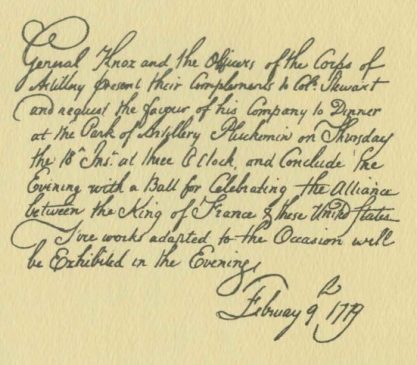
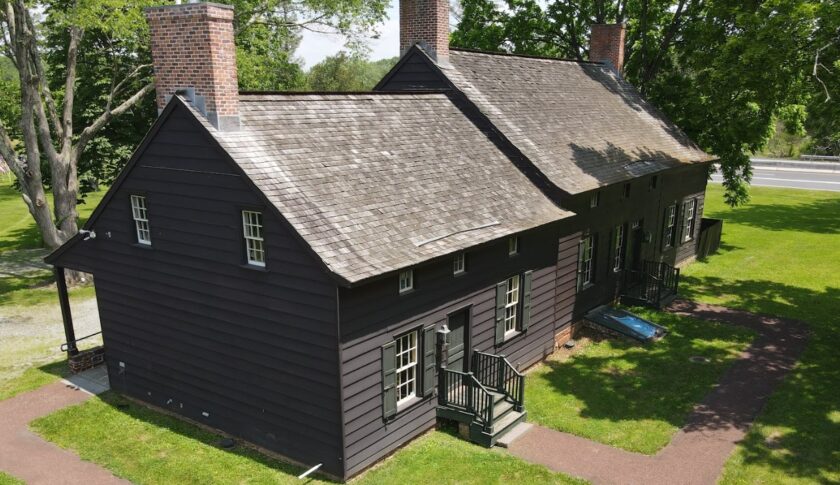




In the book Strange and Mysterious Past in the Somerset Hills by Valerie Barnes, there is a story about the Pluckemin Stone Mystery. The book was printed in 1975, before the 1979 dig began. Apparently at the sight of what we now know was a Cantonment sits 65 massive stones in a 150 ft long line. Sited in the story are thoughts from Retired Col. James Van Horn. In his book Historical Collections of NJ are some of the first published accounts of the academy and a “crude temple with 13 arches” used for celebrations.